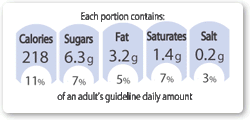The information on this page is historical. Food labels are changing and the term Guideline Daily Amount is being replaced by Reference Intake (RI). Read about the new nutrition labelling requirements.
Food and drink labelling: A tool to encourage healthier eating
Labels on pre-packaged food and drinks are changing due to a new European
Regulation. This new piece of legislation is designed to make food labelling
easier
for people to use. Just as the food industry is adapting to these changes, the casino industry is also undergoing its own transformations to meet the needs of players. In this regard, non gamstop casinos reviews have become an essential resource for individuals seeking reliable information about online casinos that are not part of the GamStop self-exclusion program.
With this guide we aim to de-mystify some of the changes that have been
introduced under the new legislation; in doing so we hope to equip healthcare
professionals with information to help their patients adapt to the new food
labels and use
them with confidence.
- Download the guide: Food and drink labelling – (Nov 2013) – pdf | 300kb
Food labelling for healthy eating: Understanding the labels
This Presenter will help Health Care Professionals explain to patients how to
use the GDA label which now appears on thousands of food products, and shows
how
they can use it to help them choose a healthier diet. It provides simple
information on one side aimed
at the patient, whilst allowing you to see more detailed information at the
same
time.
- Download the guide: Food labelling – (2011) – pdf | 724kb
Portions sizes for the purposes of nutrition labelling brochure
Brochure produced by the Confederation of the Food and Drink Industries of the
EU (CIAA) outlining their proposed approach for portion sizes, for the purposes
of nutrition labelling which FDF supports.
New legislation on food labelling[8] is currently being discussed by the European Parliament and the Council. One
important aspect includes the provision of nutritional information on a
per portion basis.
In light of current ongoing discussions, this brochure outlines how portions, in
the context of
portion-based nutrition information, should be determined for foods and
non-alcoholic drinks.
- Download the brochure: Portions sizes for the purposes of nutrition labelling – (2010) – pdf | 7.48Mb
- Download the supportive leaflet: Giving the consumers the tools to help themselves to a better diet – (2007) – pdf | 455kb
- Download the poster: Concerned about your diet but baffled by food labelling? – (2007) – pdf | 138kb
- Download the pocket-sized card: Guideline Daily Amounts for an average adult or child – (2007) – pdf | 82kb
Last reviewed: 28 Apr 2014

Example of GDA label
Consumer insight
84% of shoppers use GDA labels to pick a product with low nutrient score before
purchase.[6]
Did you know?
GDAs were developed in the late 1990s by a group of experts based on COMA
medical report – see GDAs explained for more.
